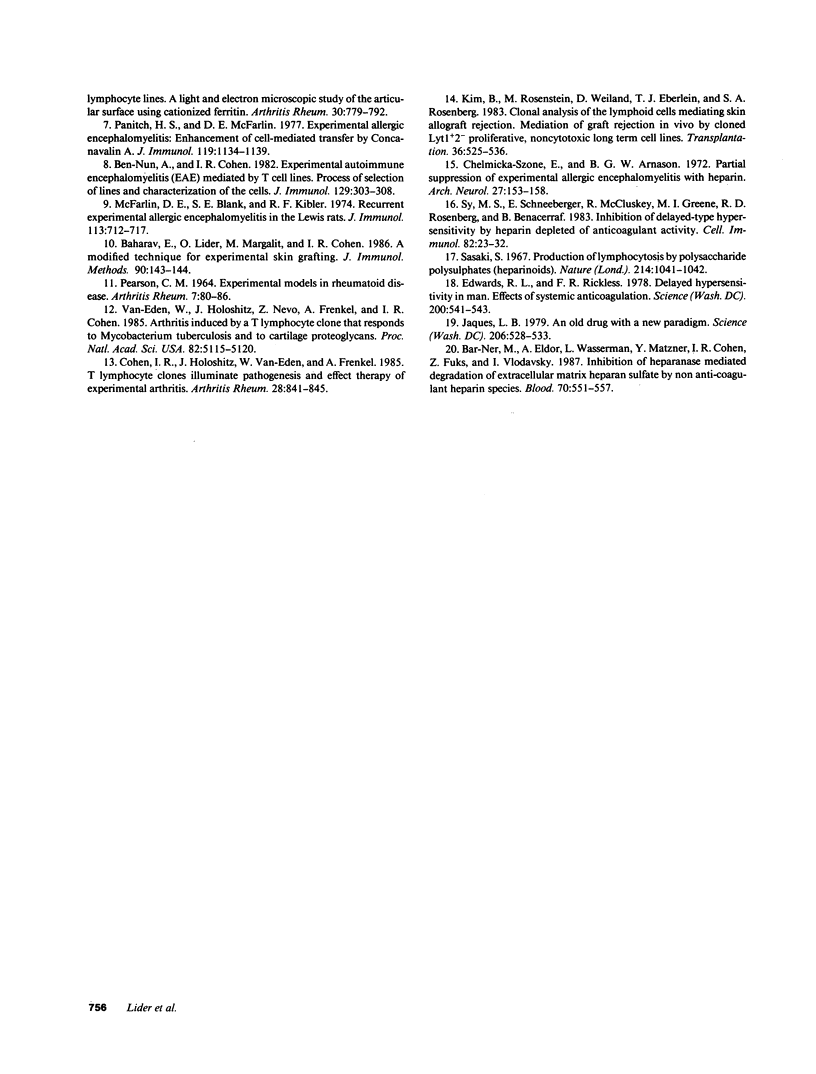Abstract
The ability of activated T lymphocytes to penetrate the extracellular matrix and migrate to target tissues was found to be related to expression of a heparanase enzyme (Naparstek, Y., I. R. Cohen, Z. Fuks, and I. Vlodavsky. 1984. Nature (Lond.). 310:241-243; Savion, N., Z. Fuks, and I. Vlodavsky. 1984. J. Cell. Physiol. 118:169-176; Fridman, R., O. Lider, Y. Naparstek, Z. Fuks, I. Vlodavsky, and I. R. Cohen. 1987. J. Cell. Physiol. 130:85-92; Lider, O., J. Mekori, I. Vlodavsky, E. Baharav, Y. Naparstek, and I. R. Cohen, manuscript submitted for publication). We found previously that heparin molecules inhibited expression of T lymphocyte heparanase activity in vitro and in vivo, and administration of a low dose of heparin in mice inhibited lymphocyte traffic and delayed-type hypersensitivity reactions (Lider, O., J. Mekori, I. Vlodavsky, E. Baharav, Y. Naparstek, and I. R. Cohen, manuscript submitted for publication). We now report that treatment with commercial or chemically modified heparins at relatively low doses once daily (5 micrograms for mice and 20 micrograms for rats) led to inhibition of allograft rejection and the experimental autoimmune diseases adjuvant arthritis and experimental autoimmune encephalomyelitis. Higher doses of the heparins were less effective. The ability of chemically modified heparins to inhibit these immune reactions was associated with their ability to inhibit expression of T lymphocyte heparanase. There was no relationship to anticoagulant activity. Thus heparins devoid of anticoagulant activity can be effective in regulating immune reactions when used at appropriate doses.
Full text
PDF




Selected References
These references are in PubMed. This may not be the complete list of references from this article.
- Baharav E., Lider O., Margalit M., Cohen I. R. A modified technique for experimental skin grafting. J Immunol Methods. 1986 Jun 10;90(1):143–144. doi: 10.1016/0022-1759(86)90395-9. [DOI] [PubMed] [Google Scholar]
- Bar-Ner M., Eldor A., Wasserman L., Matzner Y., Cohen I. R., Fuks Z., Vlodavsky I. Inhibition of heparanase-mediated degradation of extracellular matrix heparan sulfate by non-anticoagulant heparin species. Blood. 1987 Aug;70(2):551–557. [PubMed] [Google Scholar]
- Ben-Nun A., Cohen I. R. Experimental autoimmune encephalomyelitis (EAE) mediated by T cell lines: process of selection of lines and characterization of the cells. J Immunol. 1982 Jul;129(1):303–308. [PubMed] [Google Scholar]
- Chelmicka-Szorc E., Arnason B. G. Partial suppression of experimental allergic encephalomyelitis with heparin. Arch Neurol. 1972 Aug;27(2):153–158. doi: 10.1001/archneur.1972.00490140057009. [DOI] [PubMed] [Google Scholar]
- Cohen I. R., Holoshitz J., van Eden W., Frenkel A. T lymphocyte clones illuminate pathogenesis and affect therapy of experimental arthritis. Arthritis Rheum. 1985 Aug;28(8):841–845. doi: 10.1002/art.1780280802. [DOI] [PubMed] [Google Scholar]
- Edwards R. L., Rickles F. R. Delayed hypersensitivity in man: effects of systemic anticoagulation. Science. 1978 May 5;200(4341):541–543. doi: 10.1126/science.644314. [DOI] [PubMed] [Google Scholar]
- Fridman R., Lider O., Naparstek Y., Fuks Z., Vlodavsky I., Cohen I. R. Soluble antigen induces T lymphocytes to secrete an endoglycosidase that degrades the heparan sulfate moiety of subendothelial extracellular matrix. J Cell Physiol. 1987 Jan;130(1):85–92. doi: 10.1002/jcp.1041300113. [DOI] [PubMed] [Google Scholar]
- Holoshitz J., Naparstek Y., Ben-Nun A., Cohen I. R. Lines of T lymphocytes induce or vaccinate against autoimmune arthritis. Science. 1983 Jan 7;219(4580):56–58. doi: 10.1126/science.6336851. [DOI] [PubMed] [Google Scholar]
- Kim B., Rosenstein M., Weiland D., Eberlein T. J., Rosenberg S. A. Clonal analysis of the lymphoid cells mediating skin allograft rejection. Mediation of graft rejection in vivo by cloned Lyt-1+2- proliferative, noncytotoxic long-term cell lines. Transplantation. 1983 Nov;36(5):525–532. doi: 10.1097/00007890-198311000-00011. [DOI] [PubMed] [Google Scholar]
- McFarlin D. E., Blank S. E., Kibler R. F. Recurrent experimental allergic encephalomyelitis in the Lewis rat. J Immunol. 1974 Aug;113(2):712–715. [PubMed] [Google Scholar]
- Naparstek Y., Cohen I. R., Fuks Z., Vlodavsky I. Activated T lymphocytes produce a matrix-degrading heparan sulphate endoglycosidase. Nature. 1984 Jul 19;310(5974):241–244. doi: 10.1038/310241a0. [DOI] [PubMed] [Google Scholar]
- PEARSON C. M. EXPERIMENTAL MODELS IN RHEUMATOID DISEASE. Arthritis Rheum. 1964 Feb;7:80–86. doi: 10.1002/art.1780070111. [DOI] [PubMed] [Google Scholar]
- Panitch H. S., McFarlin D. E. Experimental allergic encephalomyelitis: enhancement of cell-mediated transfer by concanavalin A. J Immunol. 1977 Sep;119(3):1134–1137. [PubMed] [Google Scholar]
- Sasaki S. Production of lymphocytosis by polysaccharide polysulphates (heparinoids). Nature. 1967 Jun 3;214(5092):1041–1042. doi: 10.1038/2141041a0. [DOI] [PubMed] [Google Scholar]
- Savion N., Vlodavsky I., Fuks Z. Interaction of T lymphocytes and macrophages with cultured vascular endothelial cells: attachment, invasion, and subsequent degradation of the subendothelial extracellular matrix. J Cell Physiol. 1984 Feb;118(2):169–178. doi: 10.1002/jcp.1041180209. [DOI] [PubMed] [Google Scholar]
- Stanescu R., Lider O., van Eden W., Holoshitz J., Cohen I. R. Histopathology of arthritis induced in rats by active immunization to mycobacterial antigens or by systemic transfer of T lymphocyte lines. A light and electron microscopic study of the articular surface using cationized ferritin. Arthritis Rheum. 1987 Jul;30(7):779–792. doi: 10.1002/art.1780300708. [DOI] [PubMed] [Google Scholar]
- Sy M. S., Schneeberger E., McCluskey R., Greene M. I., Rosenberg R. D., Benacerraf B. Inhibition of delayed-type hypersensitivity by heparin depleted of anticoagulant activity. Cell Immunol. 1983 Nov;82(1):23–32. doi: 10.1016/0008-8749(83)90137-5. [DOI] [PubMed] [Google Scholar]
- Trentham D. E., Brahn E., Williams W., McCune W. J., Belli J. E. Connective tissue disease can develop in rats either spontaneously or after total lymphoid irradiation. J Rheumatol. 1984 Jun;11(3):410–412. [PubMed] [Google Scholar]
- van Eden W., Holoshitz J., Nevo Z., Frenkel A., Klajman A., Cohen I. R. Arthritis induced by a T-lymphocyte clone that responds to Mycobacterium tuberculosis and to cartilage proteoglycans. Proc Natl Acad Sci U S A. 1985 Aug;82(15):5117–5120. doi: 10.1073/pnas.82.15.5117. [DOI] [PMC free article] [PubMed] [Google Scholar]


